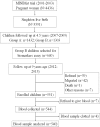Maternal Micronutrient Supplementation and Long Term Health Impact in Children in Rural Bangladesh
- PMID: 27537051
- PMCID: PMC4990280
- DOI: 10.1371/journal.pone.0161294
Maternal Micronutrient Supplementation and Long Term Health Impact in Children in Rural Bangladesh
Abstract
Background: Limited data is available on the role of prenatal nutritional status on the health of school-age children. We aimed to determine the impact of maternal micronutrient supplementation on the health status of Bangladeshi children.
Methods: Children (8.6-9.6 years; n = 540) were enrolled from a longitudinal mother-child cohort, where mothers were supplemented daily with either 30mg iron and 400μg folic acid (Fe30F), or 60mg iron and 400μg folic acid (Fe60F), or Fe30F including 15 micronutrients (MM), in rural Matlab. Blood was collected from children to determine the concentration of hemoglobin (Hb) and several micronutrients. Anthropometric and Hb data from these children were also available at 4.5 years of age and mothers at gestational week (GW) 14 and 30.
Results: MM supplementation significantly improved (p≤0.05) body mass index-for-age z-score (BAZ), but not Hb levels, in 9 years old children compared to the Fe30F group. MM supplementation also reduced markers of inflammation (p≤0.05). About 28%, 35% and 23% of the women were found to be anemic at GW14, GW30 and both time points, respectively. The prevalence of anemia was 5% and 15% in 4.5 and 9 years old children, respectively. The adjusted odds of having anemia in 9 year old children was 3-fold higher if their mothers were anemic at both GW14 and GW30 [Odds Ratio (OR) = 3.05; 95% Confidence Interval (CI) 1.42, 6.14, P = 0.002] or even higher if they were also anemic at 4.5 years of age [OR = 5.92; 95% CI 2.64, 13.25; P<0.001].
Conclusion: Maternal micronutrient supplementation imparted beneficial effects on child health. Anemia during pregnancy and early childhood are important risk factors for the occurrence of anemia in school-age children.
Conflict of interest statement
Figures


References
-
- NMS (2013) National Micronutrients Status Survey 2011–12. ICDDR,B, UNICEF, Bangladesh, GAIN and Institute of Public Health and Nutrition.
-
- WHO (2008) Worldwide prevalence of anemia 1993–2005:WHO global database on anemia. Geneva.
MeSH terms
Substances
LinkOut - more resources
Full Text Sources
Other Literature Sources
Medical

